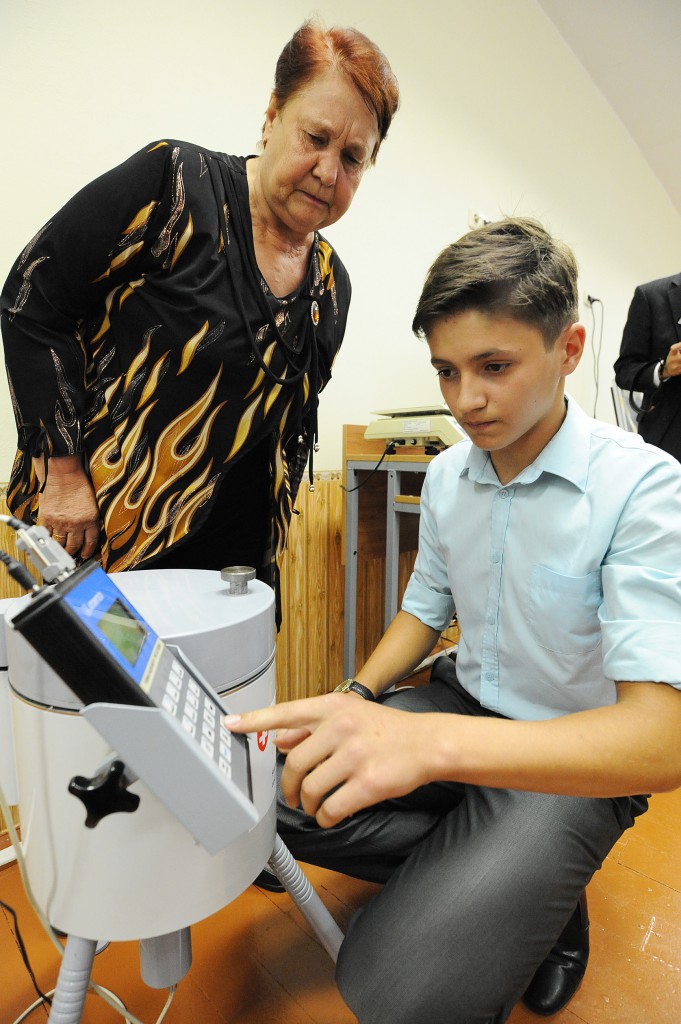Tomokatsu Sowa
Strelichevo junior high school in Khoiniki district of Belarus’ Gomel region was closed after the Chernobyl nuclear accident, but resumed in 2003. Currently, some 150 students between fifth grade of elementary school and third grade of junior high attend the school, revitalizing the area.
In 2006, the Belarus government built a radiation culture center inside the school with the support of the private sector. The center has a radiation measuring device which can be used by students to deepen understanding for radioactive substances. The device is used in chemistry and physics classes and in club activities.
On Saturdays, students operate the device to measure radiation in food products brought by local residents. The students input the weight of the products, measure radiation for five minutes in an accustomed manner, and tell the results to the residents. Through the activities, the students are learning ways to distinguish safe food.
Last year, the center measured radiation in samples of 140 food products brought to the center by local residents, and found radiation levels exceeding the safety limit in 5 percent of the products, mainly products growing in forests such as wild strawberries, gooseberries and mushrooms. Vice Principal Elena Mikhail stresses the need to acquire ways to coexist with radioactive substances.
The school places radiation education as a part of teaching daily life habits such as washing hands carefully. Students learn the history of the nuclear accident, its effects to their health and Belarus’ strict inspection system for food products.
Students are taught useful tips for reducing radioactive substances in food. Cesium in cabbages declines to one-fortieth of the original level if outside leaves are removed. Cucumbers and tomatoes do not easily absorb radioactive substances. Marinade used to make pickles should be thrown away. Such measures spread throughout the community via students’ households.
Gorgob Andreevich, ninth grader (equivalent to third grade of junior high school), says their activities are extremely beneficial for the district.

A student (right) conducts radioactivity inspection of a sample of food using a radiation measuring device in Khoiniki district of Belarus’ Gomel region.
Yana Chernivskaya, vice head of the district’s executive committee, says she hopes the center will play the role of conveying information on radioactive substances from children to their parents and eventually help raise awareness among local residents.
There are roughly 50 radiation culture centers located in schools and libraries in Belarus, with six of them in Khoiniki.
Tamara Kuzminkov, a farmer, says that right after the accident, people had no information so they were worried because they did not know what they could eat. But now the situation is different, she says, adding that in dealing with radioactive substances, it is important to nurture ability to judge the safety of food products based on the information available.
Jun Hasebe, a 40-year-old mother of two children and a member of a cooperative in Fukushima who joined the delegation, says that people in Fukushima also have worries about radioactive substances, and some mothers have doubts even if the given information is correct. She was impressed by the radiation education in Belarus, saying that it would be easy for mothers to accept knowledge obtained by their children.
Currently, schools in Fukushima are giving their students more opportunities to learn about radioactive substances in classes. Shunichiro Sato, superintendent of Fukushima city’s board of education who headed the delegation, said that the city will consider how to adopt radiation measuring devices in classes and what kind of education is desirable.
(Aug. 9, 2013)

